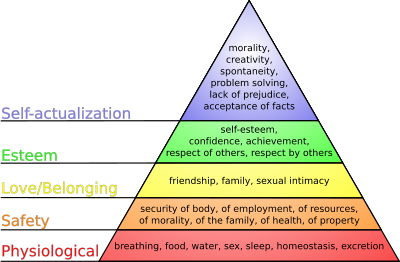Abraham Maslow and his theory
Abraham Maslow’s hierarchy of needs is often depicted as a pyramid, a structure that elegantly illustrates the foundation and ascension of human motivation. However, envisioning this hierarchy through a unique interpretation can deepen our understanding and application of Maslow’s theory. Let’s explore a metaphorical interpretation, comparing Maslow’s hierarchy to the lifecycle of a tree, a living symbol of growth and development.

Seed and Soil: Physiological Needs
Just as a seed requires fertile soil, adequate water, and the right temperature to germinate, humans have fundamental physiological needs that must be met to ensure survival. These include air, water, food, shelter, and sleep. Without these basic conditions, neither a tree nor a person can thrive or advance to the next stages of growth.
Roots: Safety Needs
As a tree’s roots grow, they anchor the plant and absorb water and nutrients, providing stability and safety. Similarly, humans seek security through employment, health, and property. A strong foundation in safety allows individuals to feel secure in their environment, ready to explore further growth.
Trunk and Branches: Love and Belonging
The trunk and branches provide the structure for the tree, just as relationships and social connections offer support and structure in human lives. Love, friendship, and a sense of belonging are crucial for psychological growth, allowing individuals to branch out and form connections with the world around them.
Leaves: Esteem Needs
Leaves are the site of photosynthesis, converting sunlight into energy. This mirrors the human need for esteem and recognition, where individuals draw energy from their achievements, respect, and the appreciation of others. Just as leaves enable a tree to grow and thrive, esteem boosts confidence and competence.
Flowers and Fruit: Self-Actualization
The pinnacle of a tree’s lifecycle is the flowering and fruiting stage, symbolizing the realization of its potential. For humans, self-actualization represents reaching one’s fullest potential, flowering in creativity, problem-solving, and personal growth. It’s the stage of bearing fruit through achievements that are not just for personal gain but also contribute to the wellbeing of others.
Seasonal Cycles: Beyond Self-Actualization
Maslow later suggested experiences beyond self-actualization, akin to a tree that goes through cycles, shedding leaves and growing anew. These peak experiences and moments of transcendence reflect a continuous process of growth, renewal, and contribution to the larger ecosystem.
This unique interpretation of Maslow’s hierarchy as the lifecycle of a tree not only illustrates the dynamic nature of human growth but also emphasizes the interconnectedness of our needs with the environment around us. Just as a tree interacts with its surroundings, human growth is influenced by and contributes to the world, underscoring the holistic nature of personal development.